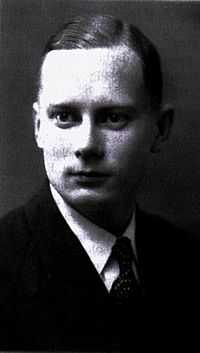Eriks Ādamsons
| Eriks Ādamsons | |
|---|---|
 | |
| Born |
22 June 1907 Rīga, (Now |
| Died |
28 February 1946 Rīga, (Now |
| Pen name | Eriks Rīga |
| Occupation | writer, poet, translator |
| Nationality | Latvian |
| Spouse(s) | Mirdza Ķempe, Elvīra Berta Padega |
Eriks Ādamsons (June 22, 1907 – February 28, 1946) was a Latvian writer, poet and novelist.[1]
Biography
Eriks Ādamsons was born in Riga on June 22, 1907. In 1926 he started law studies in Latvian University. He made his first publication in 1924. In the 1930s he fully devoted himself to literature. Ādamsons also worked as translator (he knew: Russian, German, English and French languages). He married young Latvian writer Mirdza Ķempe in 1931, but their marriage broke apart shortly before second world war.
In the years of German occupation he worked in book store and also in the lumbering. His works was banned by German authorities, so he published under pseudonym Eriks Rīga. In those years his health declined, he caught tubercolosis. In 1943 he started collect materials for book about Latvian painter Kārlis Padegs. This work was never finished. In 1944 Eriks Ādamsons married widow of Kārlis Padegs, Elvīra Berta Padega, who also suffered from tubercolosis. In 1945 they had a son Askolds, but he died after few months. In 1946 Ādamsons health declined very fast and he died in Biķernieki sanatorium on February 28, 1946. He is buried at the Rainis Cemetery in Riga.[1]
Literature
Eriks Ādamsons was known as an aesthete in life and also in his works. His novels and poems are sometimes called ornamental literature because he described details very well. His poetry is referred to through dekadence, baroque, rococo and jugendstil. His biggest influences were works by Oscar Wilde and Knut Hamsun.
Works
- "Sudrabs ugunī" (1932)
- "Smalkās kaites" (1937)
- "Ģerboņi" (1937)
- "Saules pulkstenis" (1941)
- "Lielais spītnieks" (1942)
- "Sava ceļa gājējs" (1943–1944)
- "Sapņu pīpe" (1951)
References
|